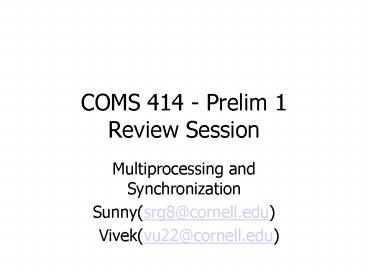COMS 414 Prelim 1 Review Session - PowerPoint PPT Presentation
1 / 15
Title:
COMS 414 Prelim 1 Review Session
Description:
Differences between O/S processes and user processes? ... No Pre Emption -- Circular Wait. Deadlock Avoidance. What is it? What is Safe State? ... – PowerPoint PPT presentation
Number of Views:46
Avg rating:3.0/5.0
Title: COMS 414 Prelim 1 Review Session
1
COMS 414 - Prelim 1 Review Session
- Multiprocessing and Synchronization
- Sunny(srg8_at_cornell.edu)
- Vivek(vu22_at_cornell.edu)
2
Prelim 1
- There are many, many resources available for your
Prelim 1 needs (presented in random order) - Your notes!
- The book and its website
- FA2000 Homeworks/Solutions
- FA2000 Prelim 1 review slides
- SP2001 Lecture notes
- Newsgroup
- Plenty of office hours!
- Additional support by appointment
3
Before we begin
- Any questions from the CS314 review session?
- Register set, stack, heap
- Program counter
- Interrupts / exceptions
- Interrupt priority levels
- Programmable I/O vs. DMA
- Polling
- Memory protection (base/limit)
4
Multitasking
- What is a
- Process or Task?
- Thread?
- What is the difference between a program and a
process? - What is in the PCB?
- Differences between O/S processes and user
processes? - Differences between user-level threads and
kernel-level threads?
5
Multitasking
- What is kernel space?
- What is user space?
- What is a system call?
- What is a context switch?
- What states may a process be in?
- How do processes go between states?
- What is a race condition?
6
Synchronization
- What is a critical section?
- What are the three requirements for protection of
a critical section? - What is busy waiting?
- What are atomic instructions?
- What is a semaphore?
7
Synchronization
- Three levels of abstraction for concurrent
programming - Hardware instructions
- O/S functions
- Programming language constructs
8
Vivek Presents
- Classic Synchronization Problems
- Monitors, Condition Variables and Language
Support - Deadlocks, Prevention and Avoidance
9
Monitors
- What is a monitor?
- What are condition variables?
- Differentiate between semaphores and condition
variables.
10
Synchronization Problems
- Bounded buffer problem
- Readers writers problem
- Dining philosophers problems
11
Deadlock
- What is a deadlock?
- Necessary conditions for deadlock ?
12
Deadlocks
R1 R2
13
Deadlocks
R1 R2
.
.
P1
P2
P3
. . .
R3
P4
14
Deadlock Prevention
- Make sure that one of the necessary conditions
does not hold - -- Mutual exclusion
- -- Hold and Wait
- -- No Pre Emption
- -- Circular Wait
15
Deadlock Avoidance
- What is it?
- What is Safe State?
- Safety Check?
- Bankers Algorithm































